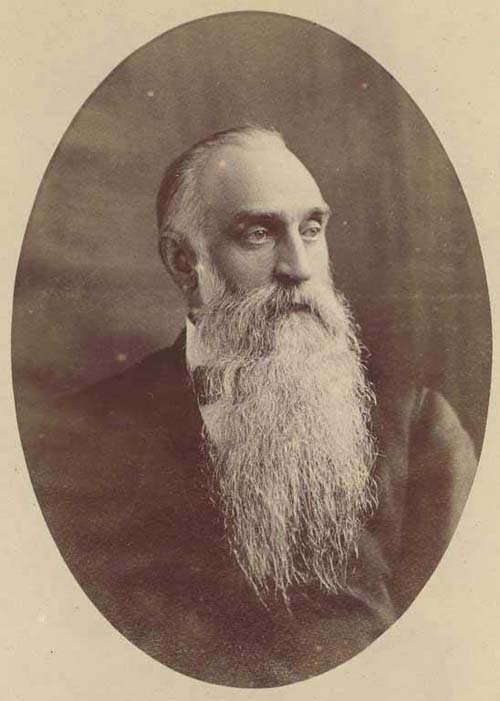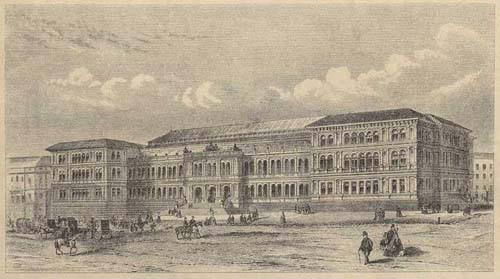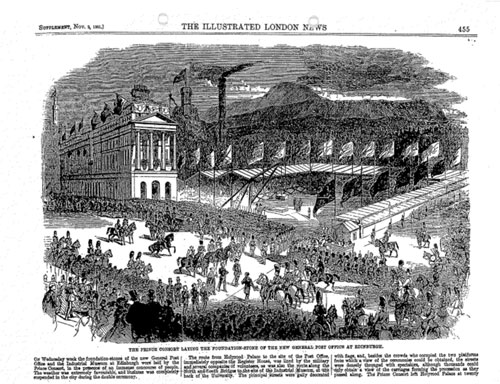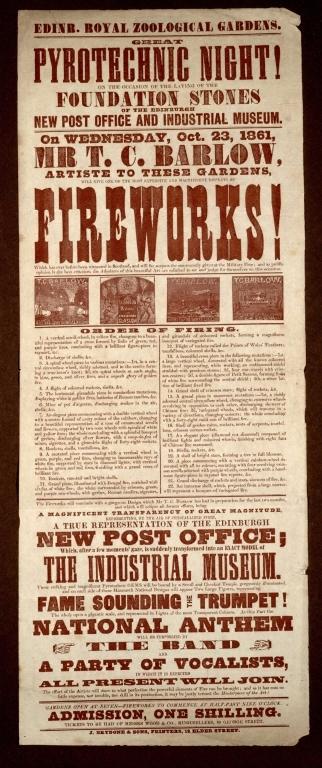Although the Industrial Museum of Scotland was founded in 1854, it was several years before its bespoke premises were constructed on Chambers Street, the building now known as the National Museum of Scotland.
The Royal Engineer, Francis Fowke, was initially asked by the Science and Art Department in London to draw up plans for “the Edinburgh Museum”, but by 1860 he was working on the detailed development with the architect for the Office of Works in Edinburgh, Robert Matheson. In May 1861 the contract documents were formally signed for what was to become the Edinburgh Museum of Science and Art.
Arrangements for the foundation stone ceremony
By October, building work had been proceeding steadily. Thomas Archer, Superintendent of the Museum, writing to the Science and Art Department in London, advised them that the date for the formal ceremony to lay the foundation stone was fixed, and that the honours would be carried out by HRH Prince Albert: “I have now learned that it is definitely arranged without fear of alteration that his Royal Highness the Prince Consort is to lay the foundation stone of the Industrial Museum on the 23rd inst.”

The ceremony was clearly going to be an exciting event for Archer, and indeed for Edinburgh in general, and by following his letters, it is hard not to feel that his nose was put out of joint by not being more involved in the arrangements, which were handled by the Lord Provosts Committee. 600 tickets were printed, of which Archer kept 200, passing the remainder to the Committee for distribution, one feels rather to his annoyance, since he later says that he had insufficient to give to all the newspapers and left this to the Committee.
Obviously he still felt that he was not being kept properly informed however, adding at the end of one letter: “PS. May I be permitted to know what steps have been taken by the Committee for the attendance of the Police at this place on the 23rd?”

Laying the foundation stone: 23 October 1861
According to the newspapers of the time, the weather on the day of the ceremony was “propitious… mild and clear, with occasional gleams of sunshine, and there was nothing to prevent, but everything to encourage, a full attendance of all classes.”
How much of Edinburgh was on holiday we do not know, but the report continues to tell how the city assumed a holiday aspect. Flags were hung from windows, especially the South and North Bridges, Princes Street, Leith Street and Waterloo Place, while floral and other decorations graced many of the premises along the route which Prince Albert was to take. The way was also lined with soldiers, including the Royal Artillery, complete with a field battery of Armstrong guns. By one o’clock, the pavements along the Bridges “had become completely blocked up” with every window and balcony along the way “crowded with fair and eager faces”.
Prince Albert was to combine two similar functions on this day, laying the foundation stone not only for the Museum, but also for the General Post Office on Waterloo Place.

After the ceremony at the Post Office, the Royal Party proceeded up the Bridges to the quadrangle of Old College, where the generosity of the University was praised in giving over their Natural History collections “so that the public may have the advantage of studying the technological specimens in connection with the natural products from which they are fashioned“. From here they went through a window and across a bridge to the site of the Industrial Museum.
There was a dense throng of spectators on the platform at the Museum site, which was covered, a wise precaution against the uncertain Edinburgh weather. The windows of the Gaelic Chapel opposite were thronged, as were all others overlooking the ceremony (Chambers Street had not yet been built, so buildings on the north side of the site were much closer than they are now).
Once the Royal Party and dignitaries were assembled, the proceedings started with prayer. Thomas Archer then deposited in a cavity in the foundation stone “a glass jar, hermetically sealed, containing the following articles:
- a copy of the Edinburgh directory;
- Oliver and Boyd’s Almanac;
- a glass jar containing the following gold and silver coins: a sovereign, a half sovereign, 5s, 2s, 6d, 2s, 1s, 6d, 4d and 3d., besides a penny, a half penny and a farthing in bronze;
- Johnson’s view of the building and the Post Office;
- Johnson’s new plan of the city;
- Lectures etc in connection with the Industrial Museum by the late Professor George Wilson;
- also a portrait engraving;
- Lecture by Professor Archer to the Chamber of Commerce;
- Hislop’s Postal Sheet for October 1861;
- Hislop’s Time-Gun plan of the city of Edinburgh;
- the Edinburgh newspapers of the 23 October 1861.”
It must have been a fair sized jar.
The trowel was presented to Prince Albert by the Right Honourable William Cowper (the Chief Commissioner of HM Works), and mortar was ceremoniously spread. The Earl of Dalkeith placed the inscription plate on the stone, and the top part of the stone was lowered (the picture of the Post Office ceremony shows the stone as two parts, the bottom section hollowed out for the container).

The Prince then re-ascended the steps into the College and, once more saying that he had been ‘highly gratified by the day’s proceedings‘, he got into the State carriage and departed. We are told that the whole proceedings only occupied a few minutes.
Queen Victoria and Prince Albert had been spending their autumn in the Highlands and it proved to be the last holiday they were to spend in Scotland before Albert’s death. Fifteen years later Victoria wistfully wrote: “The last time that my dearest Albert ever appeared in public was in Edinburgh on October 23, only six weeks before the end of all, when he laid the first stone of the new Post Office, and I looked out of the window to see him drive off in state, or rather in dress, London carriages, and the children went to see the ceremony.”

The celebrations were not over – a Great Pyrotechnic Night was being organised by one Mr T C Barlow, and was billed as “one of the most Extensive and Magnificent Display of Fireworks which has ever before been witnessed in Scotland”. The cumulating event was to be one which, apparently, Mr Barlow had been working on for two months: “being a Magnificent Transparency of great Magnitude, representing, by the aid of Crystallised Fires, a true Representation of the Edinburgh Post Office which, after a few moment’s gaze, is suddenly transformed into an Exact Model of the Industrial Museum.”
Oddly enough, after all the ceremony, the present whereabouts of the foundation stone is not known. None of the contemporary letters or reports give enough information to position it precisely. It certainly does not appear to be beneath the Earth in Space gallery, since this was stripped back to the walls in the 1960s prior to installation of the evolution galleries, nor in the area beneath the Grand Gallery, which was extensively excavated for redevelopment of the National Museum of Scotland, again with no trace being detected. The stone was presumably not too far below ground level since we know that the vaults had already been built.
It was not for another five years that the first phase of the Museum, the East Wing and two-thirds of the present Grand Gallery, was opened by Prince Alfred in 1866.
The present National Museum of Scotland has undergone various developments during its 150 history. Have a look at the most recent images of the from the re-opening of the latest re-development on 29 July 2011 and see what has changed over the years.
